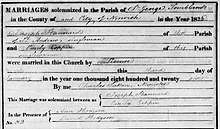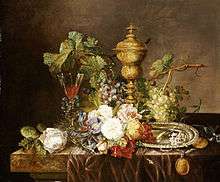Emily Coppin Stannard
| Emily Coppin Stannard | |
|---|---|
| Born |
8 February 1802 Norwich |
| Died | 6 January 1885 (aged 82) |
| Nationality | English |
| Education | parents |
| Known for | Landscape painting |
| Movement | Norwich School of painters |
Emily Coppin Stannard (8 February 1802 – 6 January 1885), also known as by her maiden name Emily Coppin, or as Mrs Joseph Stannard, was a British 19th century painter known for her still life work. She was one of only two notable women artists associated with the Norwich School of painters, Britain's first provincial art movement.
Life

Emily Coppin Stannard was born on 8 February 1802 in Norwich,[1] the daughter of Daniel Coppin and his wife Elizabeth.[2] She lived in Norwich for most of her life.[3] When a child Emily was taught art by both her parents, who were accomplished artists. Daniel Coppin was one of the founding members of the Norwich Society of Artists. Stannard travelled with her father to Holland in 1820 to study Dutch painting, which greatly influenced her subsequent work.[3]
In 1826, when already an established artist, she married the Norwich School painter Joseph Stannard. Their daughter Emily, born in 1827, inherited her parents' artistic natures. Joseph Stannard died of tuberculosis in 1830 at the age of thirty-three. Emily and her daughter were forced to supplement their income by teaching art.[4]
She died on 6 January 1885.[5]
Artistic career

In the 1800s, Norwich was still an important English city, and had an active art community that included John Crome and John Sell Cotman, two of England's finest artists of this period.[6] The city's young artists founded the Norfolk Society of Artists in 1803, and those artists associated with the Society came to be known as the Norwich School of painters. Emily Stannard was one of two notable women artists connected with the school, the other being her niece Eloise Harriet Stannard.[6]
She painted bouquets of flowers in vases and other traditional still life paintings of tableware, fruit or game animals, set against monochrome backgrounds.[7] In 1821, aged seventeen, she was awarded the Norwich Society of Artists' gold medal for one of her flower paintings. She won a second medal the following year for a painting of a collection of fruit, and a third gold medal in 1828 for a still life of game animals.[3][8] Although she usually exhibited her work in Norwich, she also exhibited at the Royal Society of British Artists in 1824 and the British Institution from 1823 to 1825.[3] One of her paintings, Still Life of Dead Ducks, a Hare with a Basket and a Sprig of Holly (1853), is in the Norwich Castle Museum, which has the largest collection of works by Emily Coppin Stannard in the world.
In Stannard's day, still life painting was treated as a second-rate form by many art critics, who considered that it took skill, but not imagination.[9] As the nineteenth century progressed, this view was displaced by a more enlightened understanding of what still life paintings could convey.[9] Emily Stannard and her niece Eloise are nowadays considered to be the finest British women still life painters of the nineteenth century.[4]
References
- ↑ Norfolk, England, Church of England Baptism, Marriages, and Burials, 1535-1812
- ↑ "Suffolk Painters". www.suffolkpainters.co.uk. Retrieved 15 August 2017.
- 1 2 3 4 Gray, The Dictionary of British Women Artists, p.249.
- 1 2 Walpole, Art and Artists of the Norwich School, p.58-59.
- ↑ England & Wales, National Probate Calendar (Index of Wills and Administrations), 1858-1966, 1973-1995
- 1 2 Ecclestone, Sue, Art Lover's Delight - Cassone Art Online - Norwich School of Artists in Cassone The Online International Art Magazine, republished on the EcclestoneArtHistory website, April 11, 2013. Accessed December 14, 2015.
- ↑ Vincent, A Companion to Victorian and Edwardian Artists.
- ↑ Mackie, Charles. Norfolk Annals: Vol. 2 (1851–1900), p.354.
- 1 2 Mühleisen et al. Eating Culture: The Poetics and Politics of Food, p.224.
Bibliography
- Ecclestone, Sue (2009). The Dictionary of British Women Artists. Cambridge: Lutterworth Press.
- Gray, Sara (2009). The Dictionary of British Women Artists. Cambridge: Lutterworth Press.
- Mackie, Charles (1901). Norfolk Annals: A Chronological Record of Remarkable Events in the Nineteenth Century Vol. 2 (1851–1900). Oxford: Norfolk Chronicle. ISBN 0-7148-2001-6.
- Mühleisen, Susanne (2003). Eating Culture: The Poetics and Politics of Food. 'Universitätsverlag Winter. ISBN 0-7148-2001-6.
- Vincent, Adrian (1992). A Companion to Victorian and Edwardian Artists. David & Charles. ISBN 1-85149-261-5.
- Walpole, Josephine (1997). Art and Artists of the Norwich School. Woodbridge: Antique Collectors' Club. ISBN 1-85149-261-5.
External links
- Works by Emily Coppin Stannard in the Norfolk Museums Collections
- Emily Stannard - Suffolk Artists website